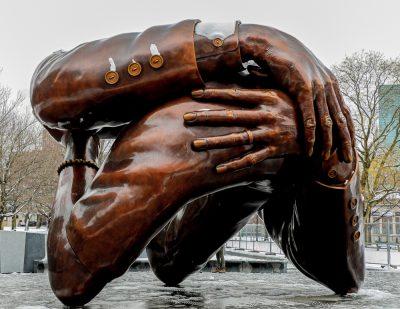
“The Embrace,” a statue commemorating Martin Luther King Jr. and Coretta Scott King, was unveiled Jan. 13 in Boston Common, generating various reactions and inspiring awe within the community.
The statue, created by artist Hank Willis Thomas and MASS Design Group, was commissioned by Embrace Boston, a non-profit organization based in Boston. The purpose of the statue is to serve as a memorial representing “the love, joy and spatial justice the Kings espoused” during their time in Boston, Embrace Boston wrote in an email.
“We are excited to be a part of the historic community process of bringing a dedication of the Kings to Boston and encourage everyone to visit the memorial to experience the artwork,” wrote Imari K. Paris Jeffries, executive director of Embrace Boston, in an email.
Harry Murphy, a sophomore at Suffolk University, was one passerby who said he thought that the sculpture had a “beautiful meaning.” Yet, he said the piece didn’t quite illustrate this message from every perspective.
“If you look at it from the angle you see in all the pictures…you can see both arms hugging each other, it looks great,” Murphy said. “But if you look at it from literally any other angle, it looks absolutely horrendous.”
Murphy also said he believes “the ultimate goal of art is to generate conversation,” and that this piece has succeeded in doing so.
Isabel Ginsberg, a senior at Emerson College, had a different view of the statue.
“It’s very majestic in person,” she said. “In the pictures, it was hard for me to…imagine the effect that it would have. In real life, it’s a beautiful tribute.”
Ginsberg said that although she and her friends had at one time made light of the statue’s appearance from several different angles, the message is still there.
Local business owner Jake Cooney said he thought the statue was “grotesque” when viewing it online, but changed his mind when he saw it at the Common.
“I really liked it a lot, because you can see the human touch, the ring, the tenderness of the hands,” he said. “You can stand underneath it and feel like you’re being hugged.”
Embrace Boston acknowledged the possibility of both positive and negative commentary in regard to “The Embrace”.
“Public art is subjective and will always come with controversy,” Jeffries wrote. “It is more than just a statue, it is the idea of embracing each other, a new Boston and a city inclusive to all walks of life.”
















































































































